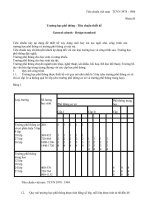Tài liệu QCXDVN 01:2002 doc
Bạn đang xem bản rút gọn của tài liệu. Xem và tải ngay bản đầy đủ của tài liệu tại đây (137.23 KB, 15 trang )
MINISTRY OF CONSTRUCTION
BUILDING CODE AND STANDARDS OF
CONSTRUCTION
FOR PEOPLE WITH DISABILITIES
CONSTRUCTION PUBLISHING HOUSE
Hanoi - 2002
VIETNAM BUILDING CODE
QCXDVN 01:2002
BUILDING CODE OF CONSTRUCTION
ACCESSIBILITY
FOR PEOPLE WITH DISABILITIES (PWD)
FOREWORD
QCXDVN 01:2002 “Building Code of Construction Accessibility for
People With Disabilities” is a legal writing stipulating minimal technical
requirements mandatory to be enforced in the construction of buildings.
QCXDVN 01:2002 is compiled on the basis of the Ordinance on
PWD:
Article 26.- “The investment for new construction or reconstruction of
dwelling houses, of public amenities and for design, manufacture of domestic
furnitures, of transport and communication means ... must take into account
the needs for convenient use by PWD, firstly of mobility and sight PWD, and
at the same time have to comply with construction codes, standards issued by
competent state agencies”.
QCXDVN 01:2002 is compiled by the Research Institute for
Architecture –Ministry of Construction and Panel for elaborating “Building
Codes and Standards of Construction Accessibility for People With
Disabilities”, submitted by the Department of Science and Technology -
Ministry of Construction, has been approved, signed and issued by the said
Ministry for enforcement.
QCXDVN 01:2002 has been compiled with the cooperation and
financial assistance by the President Committee on Employment of People
with Disabilities (PCEPD) and the Vietnam Assistance for Handicapped
(VNAH).
QCXDVN 01:2002
BUILDING CODE OF CONSTRUCTION ACCESSIBILITY
FOR PEOPLE WITH DISABILITIES (PWD)
Article 1. Scope of application
1.1. This code stipulates requirements to be met in the new construction of
works for ensuring the accessibility and use by mobility and sight
PWD.
Note: People with mobility and sight impairment are called PWD
1.2. In cases of need for reconstruction, upgrade of works with
requirements for ensuring accessibility and use by PWD, the
stipulations in this Code must be enforced.
1.3. Stipulations in the Code are used for the appraisal, permit granting,
approval and takeover of investment and construction projects.
Article 2. General requirements
2.1. The following types of building works must ensure accessibility and use
by PWD:
2.1.1. Health care buildings:
- Hospital;
- Orthopedic and functional restoration/ recovery centers;
- Disease consultation and treatment units;
- Sanatorium centers.
2.1.2. Different levels’ administrative bodies/organs;
- Different levels’ executive committees’ offices;
- Tribunals, prosecution institutes;
- Offices of organizations and bodies for state administration.
2.1.3. Educational buildings:
- Primary schools of different levels;
- Vocational schools;
- Universities
- Specialized secondary schools
2.1.4. Gymnastic and sport buildings
- Stadiums, sport ground
- Sport contest building, premises
2.1.5. Cultural works
- Parks, entertainment /leisure places, zoos;
- Theaters, cinemas;
- Museums, exhibition centers;
- Culture palaces, clubs;
- Libraries
- Tourism areas, heritages, vestiges, picturesque landscapes.
2.1.6. Public service buildings
- Hotels, rest houses, boarding houses;
- Airports, railway stations, bus stations, passenger harbors;
- Restaurants;
- Post offices;
- Trade centers, supermarkets, markets;
- Banks.
2.1.7. Collective houses
2.1.8. Roads and sidewalks
2.2. In detailed planning of open public areas such as municipal squares,
parks, tourism areas... it is mandatory to abide by this code.
Note:
Interior areas in following works, no need for design ensuring
accessibility and use by PWD:
- Areas for the purpose of security, safety, or of fire
prevention/fighting for buildings
- Places with restricted space, very narrow walks, intervals between
equipment, goods delivery areas, equipment distribution or
underground ways.
- Areas frequented by equipment maintaining, repairing, controlling
agents.
2.3. Permitted solutions are asserted as meeting requirements where
houses and buildings are constructed according to this Code and
TCXDVN 264:2002 standard – Houses and Buildings – Basic rules
for construction accessibility and use by PWD.
Article 3. Terminology – Definition.
3.1. In this Code, the sub-mentioned words and terms are interpreted as
follows:
3.1.1. Works for ensuring accessibility and use by PWD: are constructional
environment created so as PWD could access to and make use of
functional space in the said works.
3.1.2. People with disabilities (PWD): are people lacking body part(s) or
function(s) under the form of different infirmities reducing their
power of action, making it difficult for daily activities, study and
labour.
3.1.3. Mobility handicap/disability: state of body being defected, thus
reducing the power of motion in normal walking, studying, operating,
conducive to partial or total relying on aid by tools/devices or by
another person.
3.1.3.1. Defect: the missing, lacking or abnormality in functional-surgical-
physiological structure of human body caused by diseases or
accidents.
3.1.3.2. Functional reduction/decrease: the partial missing, reduction of
function(s) of some body organ caused by defect: multilation,
crippling of members engendering difficulties in walking,
paralysed hand, blindness.
3.1.4. Wheelchair user: people unable to walk by oneself, having recourse
to wheelchair.
3.1.5. People with difficult displacement: people who could move by the aid
of crutches, walking sticks (canes) sustained cages.
3.1.6. Building works: The whole or any part, any structure or land area in
which there are services rendered or activities implemented.
Note: the term “building works” in this code should be understood as
comprising public works, houses, routes and sidewalks.
3.1.7. Public entrances: Main entrances for visitors coming in the works
3.1.8. Entrances for service activities: Entrances mainly utilized for delivery
of goods or services.
3.1.9. Areas for public activities: Internal or exterior spaces reserved to
public activities .
3.1.10. Warning signs that could be identified /recognized: Characteristic
signs of a standardized surface put in or placed on superficies of
pedestrian’s way or other structures for warning blind people about
unexpected hazards on the way.
3.1.11. Slope: Path is sloping when one changes from a height to another.
3.1.12. Sidewalk slope: Portion of slope from the road level to the sidewalk.
3.11.13. Pedestrian way: Way reserved to pedestrians
3.1.14. Mechanized vehicles’ road: Road reserved to mechanized vehicles.
3.1.15. Road crossing way: Part of road reserved to pedestrians across
mechanized vehicles’ road.
3.1.16. Lateral slope: Slope perpendicular to walking direction.









